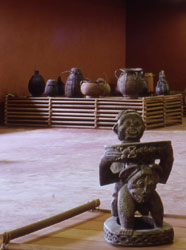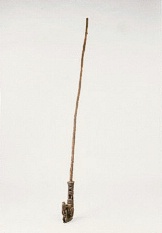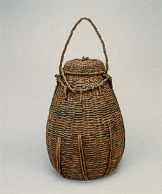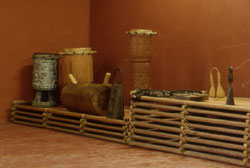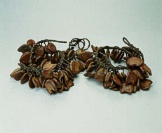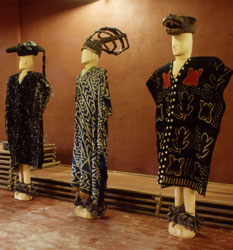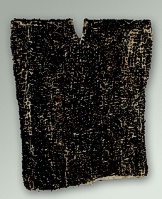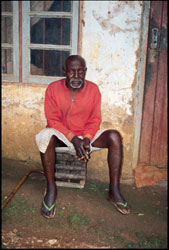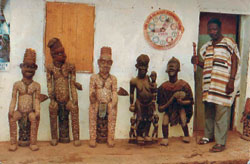
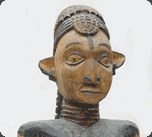 |
|
| Mankon museum | |
| Permanent exhibition | |
| |
|
| |
|
| Informations | |
Creativity, Artists and Craftsmen
The statues
Apart from some zoomorphic figures, the statues and statuettes are anthropomorphic. They are generally dynamic, vigorous and expressive. This production, sometimes covered by beads or cowries, represent or commemorate kings, queens, princesses, notables, servants and protector guardians.Some of the pieces are used in different ritual functions in the community (cult of ancestors, divining, healing, justice, twin worship, agricultural and fertility rites).All these objects are not displayed in public and those that are associated with an occult power are often placed away from indiscreet eyes, outside the royal quarter. Lastly, some figures have no religious function.
The masks
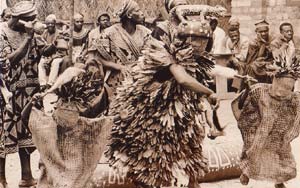 |
The mask is one of the most outstanding symbolic expressions of the art of Mankon. It belongs to a specific regulatory society that uses it in processions, dances or ceremonies. It has to evoke and prove the presence of the supernatural, at times even amuse. It does not only include the pieces of wood used to hide the head or face, but also the costumes and accessories that are an integral part of it. It is associated with a rite, a dance, a choreography and appropriate music during events. Masks have specific functions on the political, religious, therapeutic, ritual, social or legal level. | |
| |
||
The woodenheads kept in the Palace of Mankon are above all anthropomorphic and zoomorphic, but sometimes can be anthropo-zoomorphic, and even hybrid. The zoomorphic masks catalogued are those of cattle, elephants, monkeys, birds and, more rarely, leopards and crocodiles. |
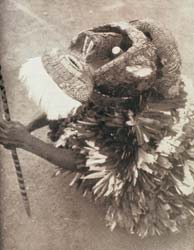 |
|
| |
||
|
|
|
|
|
The heritage of Mankon includes a wide variety of pots, vases, cups, jars, bowls, jugs, pitchers, bags and other recipients (made of clay, wood or other materials) for different uses (ritual material, ceremonial objects, cooking utensils etc.). The pieces that are to keep, store or prepare cult or prestige products (camwood powder and different beverages for initiations, palm wine and oil for libations, sauces, tobacco etc.) are sculpted, woven or modelled with great care. They are decorated with geometric motifs or symbolic figures which can at times be exuberant. They are strictly reserved for the fon and the major dignitaries of the kingdom. The most characteristic recipients of the royal treasure can be divided into several groups: |
The pipe often includes in general a bowl that is open towards the top and bent back by a tubular chimney to receive a suction tube. The Mankon specimens are made of clay or metal (bronze, brass). Their decoration is extremely rich. The pipes with anthropomorphic or zoomorphic decorations are reserved exclusively for the fon and the major dignitaries. While some pipes were made in Mankon, the majority of the pieces were produced in other places. Mankon has not been and is not a major centre of production for such works. In addition, pipes were the object of intense trade between the different kingdoms of the Grassland. |
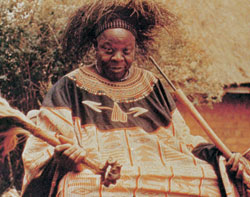 |
|
|
|
|
|
|
MUSICAL INSTRUMENTS
|
In Mankon, various musical instruments are used in leisure and different activities of social life. They may be made of iron, ivory or wood, possibly with other materials such as animal hide. They are often decorated with motifs ranging from simple geometric figures to anthropomorphic and zoomorphic figures. They can be divided into several groups: idiophones (slit drums, rattles, gongs and sanza); membranophones (drums with a single hide), string instruments (less common); wind instruments (trumpets, flutes). |
Of these, the most important in social and religious life are gongs, trumpets, flutes, xylophones, rattles, drums and sanza. A good number of musical instruments belonging to the king, notables and customary societies play a liturgical role by accompanying or giving rhythm to songs and dances with processions. Some of these objects (drums, gongs etc.) with a sacred character have been sanctified by sacrifices and magical practices. In this case looking at them is sometimes forbidden and dangerous, especially at the time when they emit sounds.
Amongst the drums, slit drums can be distinguished from membrane drums. Slit drums can be divided into two categories: the smallest are talking drums, or instruments to animate dances, beaten with appropriate sticks; the larger ones are monumental and ritual war drums. The richly decorated membrane drums with zoomorphic, anthropomorphic and geometric motifs can be further divided into two groups:
- the füka, a vertical drum with a single membrane and a slender trunk, said to be of the male sex and played as a prelude to dances ;
- the nkag, a vertical membrane drum with feet, and a squatter trunk, it is said to be of the female sex.
Weapons
The Mankon use a variety of weapons for war but also for parades, dances and ceremonies as ritual material or prestige in this case. Certain pieces are very richly decorated.
|
|
COSTUME, FINERY AND ARMS
|
In daily life, during ceremonies and dances, the Mankon wear many different costumes and symbolic, ceremonial or prestige headdresses as well as flywhisks, staffs and ceremonial spears. Royal headdresses are richly decorated with figures of animals and valuable elements (cowries, beads). The most impressive and important of these headdresses is the ma komngang which only the fon of Mankon wears during the dance. The treasure of the fon includes royal costumes (in ndob nwa’ fabric, sometimes decorated with cowries), used for dances and, in general, as ritual garments par excellence. Ndob is the richest in meanings of the different Grassland fabrics. |
Its religious, symbolic and ceremonial functions are considerable. The palace specimen is only one of the multiple types of ndob to be found in the Grassland and neighbouring peoples. The dye, the type of designs, the over-sewing of raffia allows distinguishing the varieties of ndob.
Staffs often used as supports for various symbolic motifs play in general important ritual and ceremonial functions, apart from a few contemporary specimens used as simple objects of daily life. There are a great variety of these and belong strictly to kings and notables. On his enthronement, the new fon of Mankon appears in public holding in his right hand a ceremonial staff decorated at the end with three bird feathers. This object will be kept as the sacred royal sceptre in the kwifo quarter.
Flywhisks (or dance whips) lünga each have a sculpted wooden handle (generally in an anthropomorphic or zoomorphic shape) fixed on to a horse or buffalo tail. These are real trophies displayed at funerals and dances. The spears (in local style or of foreign inspiration) are used during traditional ceremonies by the fon, his servants and the powerful members of the customary societies, as attributes of the royal power and the unity of the country.
The Mankon use a variety of weapons for war but also for parades, dances and ceremoniesas ritual or prestige material in this case. Certain specimens are richly decorated.
|
|
MANKON ARTISTS
|
The artistic objects of the Mankon palace have been produced with extreme aesthetic richness and expertise in the use of materials by talented artists (the majority of whom are sculptors) who are known and very respected by the whole community. Certainly, the identity of the authors of almost one-third of this production still remains to be determined, but with the information already collected in the field, two-thirds of the remaining works were produced by artists of Mankon (about 50%) on the one hand, Ndop artists mainly (Babanki, Tungo, Babungo, Bamessing) and a few rare Bamoum and Bangwa on the other. Certain Makon artists that have been identified are still alive, However, many others are dead and have left us these excellently crafted objects which we can admire today: Ndzah; Moses Tse Wamuchu; Ivo Tse Akor; Suka Nso; Tsi Aghazüga, etc. and women who are excellent at basket ware and pottery. |
The Mankon artist, producer of royal and noble works or those of great value, is in the first place a keeper of tradition. He is also ion the avant-garde of innovation. The production of orders in compliance with the traditional model does not exclude personal research and the inventive spirit of the creator. The latter has received solid training and a long learning (generally lasting more than fifteen years, to become a master. He has a great capacity of abstraction and synthesis and maintains a balance between naturalism and realism. |
|
In addition, the proportions he gives to the different parts of the human body and decoration are directly connected with the notions of importance and meaning. Thus, certain formal features will be highlighted to the detriment of others, which are reduced or omitted. The artist uses a carefully « coded » language in the multiple motifs that allow him to express ideas, artistic subjects, mythical scenes, historic tales etc. requested by the client. The sculptors are covered with honour and riches by the fon, the notables and the customary societies. Those who produce the objects of cult are members of these associations and count amongst the dignitaries of the kingdom.
[ Top page ]
| Home | The four museums | The project | Baham museum | Bandjoun museum | Mankon museum | Babungo museum |
| mankon@museumcam.org | Copyright 2005 C.O.E. | Powered by Synus |



















